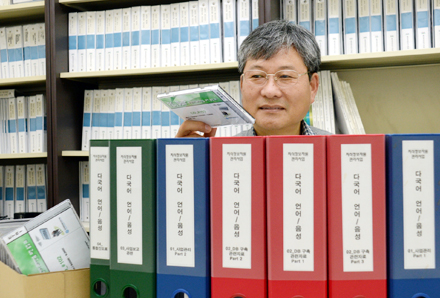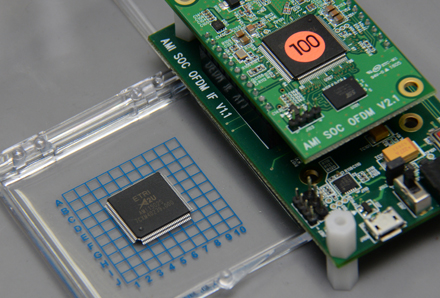
ETRI Distributes Voice Database for Four Languages ; GermanㆍRussianㆍArabicㆍVietnamese
ETRI announced its distribution of a total of 360,000 sentences in the conversational voice database of four languages and equivalent 200,000 sentences in Korean to industrial and academic sectors.
The voice database contains conversational sentences in German, Russian, Arabic, and Vietnamese. The database is used as basic data for software development of voice recognition and language translation and for research of vocal language processing. It also has potential for tablet PCs, navigation, smartphones, electronic dictionaries, and intelligent robots.
The vocal language DB is utilized for software products for travel, tourism, and language learning. The potential customers of the database include voice-controlled remote control manufacturers, foreign-language educational institutions, automatic translation service providers, automobile and navigation manufacturers, and Internet portal service providers.
The newly released database was developed as part of a project for building a smart mobile multi-language vocal database, one of the national database programs pursued by the National Informational Society Agency upon commission by the Ministry of Science, ICT and Future Planning over the period of 2011-2016.
The database distributed by ETRI contains conversational vocal database for German, Russian, Arabic, and Vietnamese as well as eight sets of those languages coupled with Korean translation.
Although commercial products using a vocal database had been independently developed with domestic technology based on the material accumulated from the national database programs, foreign-developed voice-recognition and translation engines had to be adopted in the absence of a domestic database.
Some a foreign-language database can be purchased from abroad, such as the European Language Resources Association, it costs KRW 100-200 million for a vocal database containing 300-500 speakers. On the other hand, the four-language database provided by ETRI contains a total of 2,400 speakers, and small companies are able to purchase the database at a price of only 5-10 percent of that of a foreign database.
To date, ETRI has distributed 247 database products to a total of 57 institutions in Korea, representing a reduction of cost of KRW 43 billion. ETRI explained that distributing the latest eight sets of the database to ten institutions within Korea will save KRW 12 billion.
The database being distributed by ETRI comprises 37 sets of data, with 2,300 hours of voice and 28,000 pages in A4 size.

ETRI and A2UICT to Commercialize Long-Distance Wireless Communication Chips
The IoT chip for wireless communication covering more than a two-kilometer diameter will be commercialized for the first time during 2017. This chip will use the TVWS(TV White Space) band unused for commercialized broadcasting services within the television frequency range (470-698MHz).
In partnership with a power-related institution invested in by the government, ETRI will complete the field verification of the AMI (advanced metering infrastructure) based on the wide-range communication chip on the smart-grid testbed established in Gujwa, Jeju.
In addition, ETRI will work with A2UICT in releasing a commercialized product in 2017 following the verification and testing process - the world’s first commercialization.
The white space used by the research team features a longer range of frequency compared with the existing Wi-Fi frequency and a higher penetration ratio through buildings. On the basis of these advantages, the white space is an alternative to address the busy unlicensed frequency of 2.4GHz and 5GHz caused by the explosion of Wi-Fi usage.
The newly developed technology was proposed by ETRI and adopted by the Institute of Electrical and Electronics Engineers in 2014 as an international standard. This wireless communication system adopts OFDM (orthogonal frequency division multiplexing) technology. The new chip was made in the form of SoC (system on chip) integrated with a 32-bit microcontroller unit.
The size of bare chip is 6.8mm by 6.0mm and the package size becomes 15mm by 15mm in 128 pin TQFP (thin quad flat pack) form. Our researchers are planning to eliminate the unnecessary functions and make the package size smaller than 10mm by 10mm.
Once the new communication chips are embedded within a metering device or connected with various sensors and further with the surrounding wireless communication networks or Internet, they will be able to collect or exchange data at a bidirectional speed of 400-1,600kbps.
The new chip can be used for a number of purposes. It provides wireless on/off control of lights, refrigerators, and washing machines in the smart-home service. In addition, the technology is suitable for monitoring the electricity, water, and gas usage remotely in buildings. It will also enable the smart-grid service to automatically shut down the electricity where it is not used and reduce unnecessary power consumption. The research team forecasts that the technology will be used for a wide range of IoT services, such as fire monitoring, crime prevention, care service for the elderly living alone, and management of materials at factories and shipbuilding yards.
“Since we can diversify the transmission speed, we can monitor in real time whether fire or crime has occurred in reality by referring to the images transmitted by the chips near the location in question,” explained Dr. Sangsung Choi, the project leader at the UGS Communication Research Team. “For commercialization, we will further reduce power consumption of the chip by 20 to 30 percent.”
The research was conducted as part of a project for developing smart-grid wireless communication infrastructure and applied technologies, supported by the Korea Institute of Energy Technology Evaluation and Planning in line with the energy technology development program implemented by the Ministry of Trade, Industry and Energy since 2013.